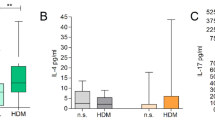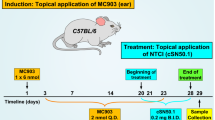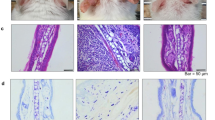Abstract
Signal transducers and activators of transcription 6 (STAT6) play a crucial role in the transactivation of IL-4 and IL-13, which might be involved in the pathogenesis of atopic dermatitis (AD). We herein reported that the IgE-mediated late-phase reaction significantly decreased in STAT6-deficient (STAT6−/−) mice in AD model mice induced by intravenous injection of monoclonal anti-dinitrophenyl (DNP)-IgE antibody and subsequent skin testing with dinitrofluorobenzene. We therefore hypothesized that synthetic double-stranded DNA with a high affinity for STAT6 could be introduced in vivo as decoy cis elements to bind the transcriptional factor and block the gene activation contributing to the onset and progression of AD, thus providing effective therapy for AD. Treatment by the transfection of STAT6 decoy oligodeoxynucleotides (ODNs), but not scramble decoy ODN after sensitization by anti-DNP-IgE antibody, had a significant inhibitory effect on not only STAT6 binding to nuclei but also on the late-phase response. A histological analysis revealed that both edema and the infiltration of neutrophils and eosinophils significantly decreased in STAT6 decoy ODN-transfected mice. To examine the mechanism of the in vivo effect of STAT6 decoy ODN, we employed an in vitro mast cells culture system. After IgE receptor engagement, mast cells transfected by STAT6 decoy ODN exhibited normal histamine release, but their cytokine release (TNF-α, IL-6) markedly decreased. We herein report the first successful in vivo transfer of STAT6 decoy ODN to reduce the late-phase reaction, thereby providing a new therapeutic strategy for AD.
This is a preview of subscription content, access via your institution
Access options
Subscribe to this journal
Receive 12 print issues and online access
$259.00 per year
only $21.58 per issue
Buy this article
- Purchase on Springer Link
- Instant access to full article PDF
Prices may be subject to local taxes which are calculated during checkout





Similar content being viewed by others
References
Michell EB et al. Basophils in allergen-induced patch test sites in atopic dermatitis. Lancet 1982; 1: 127–130.
Uehara M, Ofuji S . Patch test reactions to human skin dander in atopic dermatits. Arch Deramtol 1976; 112: 951.
Adinoff AD, Tellez P, Clark AF . Atopic dermatitis and aeroallergen in contact sensitivity. J Allergy Clin Immunol 1988; 81: 736–742.
Bruijzeel PL et al. The involvement of eosinophils in the patch test reaction to aeroallergens in atopic dermatitis: its relevance for the pathogenesis of atopic dermatitis. Clin Exp Allergy 1993; 23: 97–109.
Sampson HA . The role of food allergy and mediator release in atopic dermatitis. J Allergy Clin Immunol 1988; 81: 635–645.
Pathomechanism RG . Genetic and immunological factors. In: Essential Aspects of Atopic Deramatitis. Springer-Verlag: Tokyo, 1988, pp 108–111.
Katayama I, Tanei R, Nishioka K, Dohi Y . Induction of eczematous skin reaction in experimentally induced hyperplastic skin of BALB/c mice by monoclonal anti-DNP-IgE antibody: possible implication for skin lesion formation in atopic dermatitis. Int Arch Allergy Appl Immunol 1990; 93: 148–154.
Katayama I, Minatohara K, Yokozeki H, Nishioka K . Topical vitamin D3 downregulates IgE-mediated murine biphasic cutaneous reaction. Int Arch Allergy Immunol 1996; 111: 71–76.
Katayama I, Otoyama K, Yokozeki H, Nishioka K . Effect of mast cell modulators on IgE-mediated murine biphasic cutaneous reaction. Int Arch Allergy Immunol 1996; 109: 390–397.
Yokozeki H et al. Signal transducer and activator of Transcription 6 is essential in the induction of contact hypersensitivity. J Exp Med 2000; 191: 995–1004.
Takeda K et al. Essential role of Stat6 in IL-4 signaling. Nature 1996; 380: 627–630.
Taked K et al. Impaired IL-13-mediated functions of macrophages in STAT6-deficient mice. J Immunol 1996; 157: 3220–3222.
Morishita R et al. A gene therapy strategy using a transcription factor decoy of the E2F binding site inhibits smooth proliferation in vivo. Proc Natl Acad Sci USA 1995; 92: 5855–5859.
Morishita R et al. Role of transcriptional cis-elements, angiotensinogen gene-activating element, of angiotensinogen gene in blood pressure regulation. Hypertension 1996; 27: 502–507.
Morishita R et al. In vivo transfection of cis element ‘decoy’ against nuclear factor-κB binding site prevents myocardial infection. Nature Med 1997; 3: 894–899.
Nakamura H et al. Prevention and regulation of atopic dermatitis by ointment containing NF-κB decoy oligodeoxynucleotides in NC/Nga atopic mouse model. Gene Therapy 2002; 9: 1221–1229.
Abeyama K, Eng W, Jester JV, Vink AA . A role for NF-κB-dependent gene transaction in sunburn. J Clin Invest 2000; 105: 1751–1759.
Wang LH et al. Targeted disruption of Stat6 DNA binding activity by an oligonucleotide decoy blocks IL-4-deriven Th2 cell response. Blood 2000; 95: 1249–1257.
Malaviya R, Uckun MF . Role of STAT6 in IgE receptor/FcɛRI-mediated late phase allergic response of mast cells. J Immunol 2002; 168: 421–426.
Yagi R et al. Development of atopic dermatitis-like lesions in STAT6-deficient NC/Nga mice. J Immunol 2002; 168: 2020–2027.
Kaneda Y, Iwaki K, Uchida T . Introduction of the human insulin gene in adult rat liver. J Biol Chem 1989; 264: 12126–12129.
Hoeck J, Woisetshlager M . Activation of Eotaxin-3/CCL26 gene expression in human dermal fibroblast is mediated by stat6. J Immunol 2001; 167: 3216–3222.
Hoeck J, Woisetshlager M . STAT6 mediates eotaxin-1 expression in IL-4 or TNF-α-induced fibroblasts. J Immunol 2001; 166: 4507–4515.
Wershil BK, Wang ZS, Gordon JR, Gall J . Recruitment of neutrophils during IgE-dependent cutaneous late phase reactions in the mouse is mast cell-dependent: partial inhibition of the reaction with antiserum against tumor necrosis factor-α. J Clin Invest 2001; 87: 446.
Kitaura J et al. Akt-dependent cytokine production in mast cells. J Exp Med 2000; 192: 729–739.
Saeki Y et al. Development and characterization of cationic liposomes conjugated with HVJ (Sendai virus): reciprocal effect of cationic lipid for in vitro and in vivo gene transfer. Hum Gene Ther 1997; 8: 2133–2141.
Molitor JA et al. NF-κB: a family of inducible and differentially expressed enhancer-binding proteins in human T cells. Proc Natl Acad Sci USA 1990; 87: 10028–10032.
Schreiber EP, Matthais MM, Schaffner W . Rapid detection of octameric binding proteins with ‘mini-extracts’ prepared from a small number of cells. Nucleic Acids Res 1989; 17: 6419.
Ferguson T, Dube P, Griffith TS . Regulation of contact hypersensitivity by interleukin 10. J Exp Med 1994; 179: 1597–1674.
Malaviya R, Chen CL, Dibirdik I, Uckun FM . Targeting Janus kinase 3 in mast cells prevents immediate hypersensitivity reaction and anaphylaxis. J Biol Chem 1999; 274: 27028–27038.
Malaviya R, Abraham SN . Interaction of bacteria with mast cells. Methods Enzymol 1995; 253: 27–43.
Acknowledgements
We thank Ms Motoko Sekiya for her excellent technical assistance. This work was partially supported by the Cosmetology Research Foundation and grants (15790569 and 13670869) from the Ministry of Education, Japan.
Author information
Authors and Affiliations
Rights and permissions
About this article
Cite this article
Yokozeki, H., Wu, MH., Sumi, K. et al. In vivo transfection of a cis element ‘decoy’ against signal transducers and activators of transcription 6 (STAT6)-binding site ameliorates IgE-mediated late-phase reaction in an atopic dermatitis mouse model. Gene Ther 11, 1753–1762 (2004). https://doi.org/10.1038/sj.gt.3302341
Received:
Accepted:
Published:
Issue Date:
DOI: https://doi.org/10.1038/sj.gt.3302341
Keywords
This article is cited by
-
Eucalyptus oil reduces allergic reactions and suppresses mast cell degranulation by downregulating IgE-FcεRI signalling
Scientific Reports (2020)
-
A new approach to transfect NF-κB decoy oligodeoxynucleotides into the periodontal tissue using the ultrasound-microbubble method
International Journal of Oral Science (2017)
-
Primary Prevention of Allergic Diseases: Current Concepts and Mechanisms
Allergy, Asthma & Clinical Immunology (2007)



